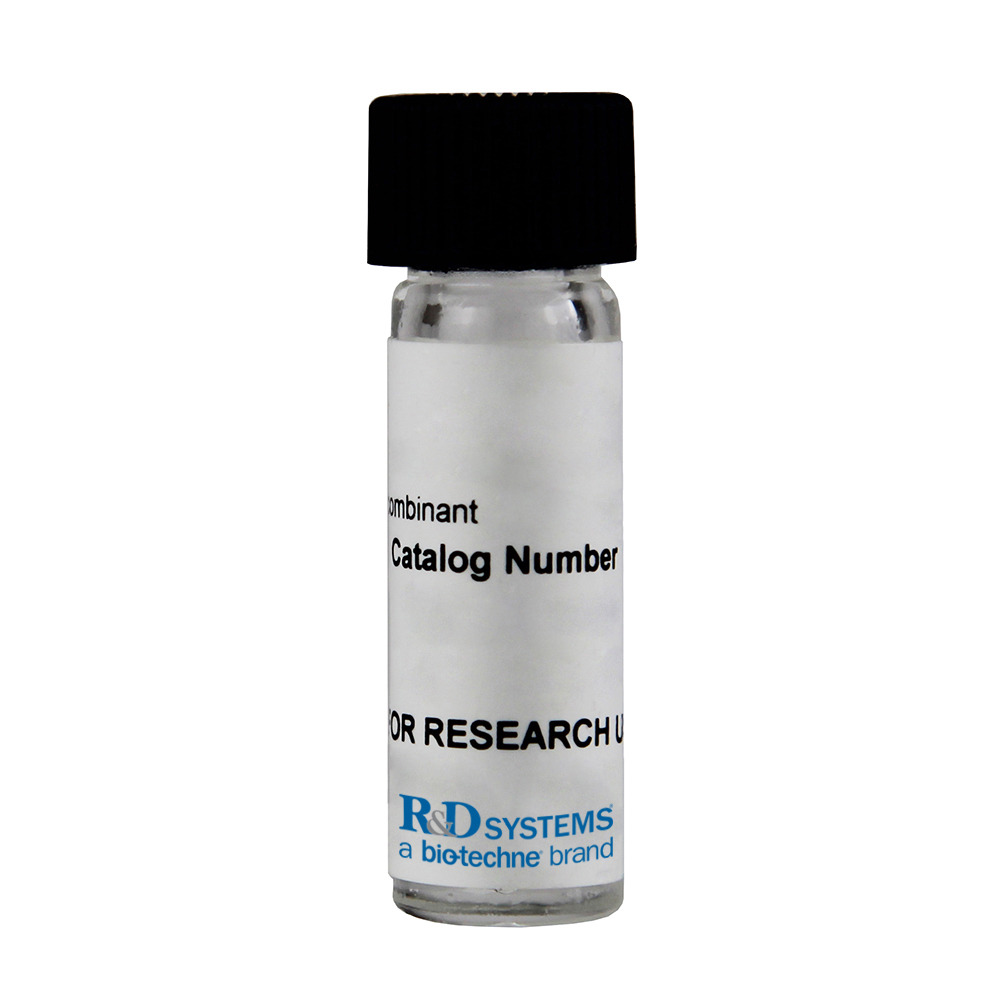Recombinant Human PLA2G2A Protein, CF Summary
Product Specifications
Asn21-Cys144, with a C-terminal 10-His tag
Analysis
Product Datasheets
Carrier Free
CF stands for Carrier Free (CF). We typically add Bovine Serum Albumin (BSA) as a carrier protein to our recombinant proteins. Adding a carrier protein enhances protein stability, increases shelf-life, and allows the recombinant protein to be stored at a more dilute concentration. The carrier free version does not contain BSA.
In general, we advise purchasing the recombinant protein with BSA for use in cell or tissue culture, or as an ELISA standard. In contrast, the carrier free protein is recommended for applications, in which the presence of BSA could interfere.
5374-PL
| Formulation | Supplied as a 0.2 μm filtered solution in Sodium Acetate and NaCl. |
| Shipping | The product is shipped with polar packs. Upon receipt, store it immediately at the temperature recommended below. |
| Stability & Storage: | Use a manual defrost freezer and avoid repeated freeze-thaw cycles.
|
Assay Procedure
- Assay Buffer: 50 mM Tris, 0.1 M NaCl, 20 mM CaCl2, 2 mg/mL BSA, pH 8.5
- Enzyme Buffer: 50 mM Tris, 0.1 M NaCl, 2 mg/mL BSA, pH 8.5
- Recombinant Human Phospholipase A2 Group IIA/PLA2G2A (rhPLA2G2A) (Catalog # 5374-PL)
- Substrate: 1-Hexadecanoyl-2-(1-Pyrenedecanoyl)-sn-Glycero-3-Phosphoglycerol Ammonium salt, 2 mM stock in DMSO
- Black 96-well Plate
- Fluorescent Plate Reader
- Thaw Substrate at 37 °C for five minutes. Mix well.
- Dilute rhPLA2G2A to 20 ng/mL in Enzyme Buffer.
- Dilute Substrate to 40 µM in Assay Buffer.
- Load 50 µL of the 20 ng/mL rhPLA2G2A into a black well plate, and start the reaction by adding 50 µL of 40 µM Substrate. Include a Substrate Blank containing 50 µL Assay Buffer and 50 µL of 40 µM Substrate without any rhPLA2-G2A.
- Read at excitation and emission wavelengths of 345 nm and 395 nm (top read), respectively, in kinetic mode for 5 minutes. Mix between reads. Use the first three minutes for data analysis.
- Calculate specific activity:
|
Specific Activity (pmol/min/µg) = |
Adjusted Vmax* (RFU/min) x Conversion Factor** (pmol/RFU) |
| amount of enzyme (µg) |
*Adjusted for Substrate Blank
**Derived using calibration standard 1-pyrenedecanoic acid
- rhPLA2G2A: 0.001 µg
- Substrate: 20 µM
Reconstitution Calculator
Background: PLA2G2A
Secretory phopholipase A2 is an enzyme that hydrolyzes the sn-2 ester bond of phospholipids, generating non-esterified free fatty acids and lysophospholipids (1-4). Most secretory PLA2s are stored in cytoplasmic granules and are released in the extracellular environment on appropriate cell activation. Thus, they are present at higher concentration in the plasma and biologic fluids of patients with systemic inflammatory, autoimmune, or allergic disease, such as acute pancreatitis, rheumatoid arthritis, bronchial asthma, and allergic rhinitis. PLA2G2A is a calcium dependent phospholipase expressed in many cell types associated with inflammation, including platelets, neutrophils, and mast cells. It has been recognized as an acute phase reactant and its concentration increases during systemic inflammation such as sepsis, rheumatoid arthritis, and cardiovascular disease (5). It may function as an enzymatic component of the host defense mechanism. For example, human tears contain a high concentration of PLA2G2A and this is the principal bactericidal factor against Gram-positive bacteria in this fluid (1). It may play a role in cell proliferation through binding a receptor on membrane surface or extracellular matrix components such as heparan sulfate proteoglycan and integrins (6). It has been shown to have pro-atherogenic properties both in the circulation and within the arterial wall (7). Circulating levels of PLA2G2A are higher in coronary artery disease (CAD) patients and are associated with increased risk of future CAD (8).
- Lambeau, G. and M.H. Gelb (2008) Ann. Rev. Biochem. 77:495.
- Webb, N.R. (2005) Curr. Opin. Lipid. 16:341.
- Triggiani, M. et al. (2005) J. Allergy Clin. Immunol. 116:1000.
- Murakami, M. and I. Kudo (2004) Biol. Pharm. Bull. 27:1158.
- Crowl, R.M. et al. (1991) J. Biol. Chem. 266:2647.
- Saegusa, J. et al. (2008) J. Biol. Chem. 283:26107.
- de Beer, F.C. and N.R. Webb (2006) Arterioscler. Thromb. Vasc. Biol. 6:1421.
- Wootton, P.T.E. et al. (2006) Human Mol. Genet. 15:355.
FAQs
No product specific FAQs exist for this product, however you may
View all Proteins and Enzyme FAQsReviews for Recombinant Human PLA2G2A Protein, CF
Average Rating: 5 (Based on 1 Review)
Have you used Recombinant Human PLA2G2A Protein, CF?
Submit a review and receive an Amazon gift card.
$25/€18/£15/$25CAN/¥75 Yuan/¥2500 Yen for a review with an image
$10/€7/£6/$10 CAD/¥70 Yuan/¥1110 Yen for a review without an image
Filter by:


